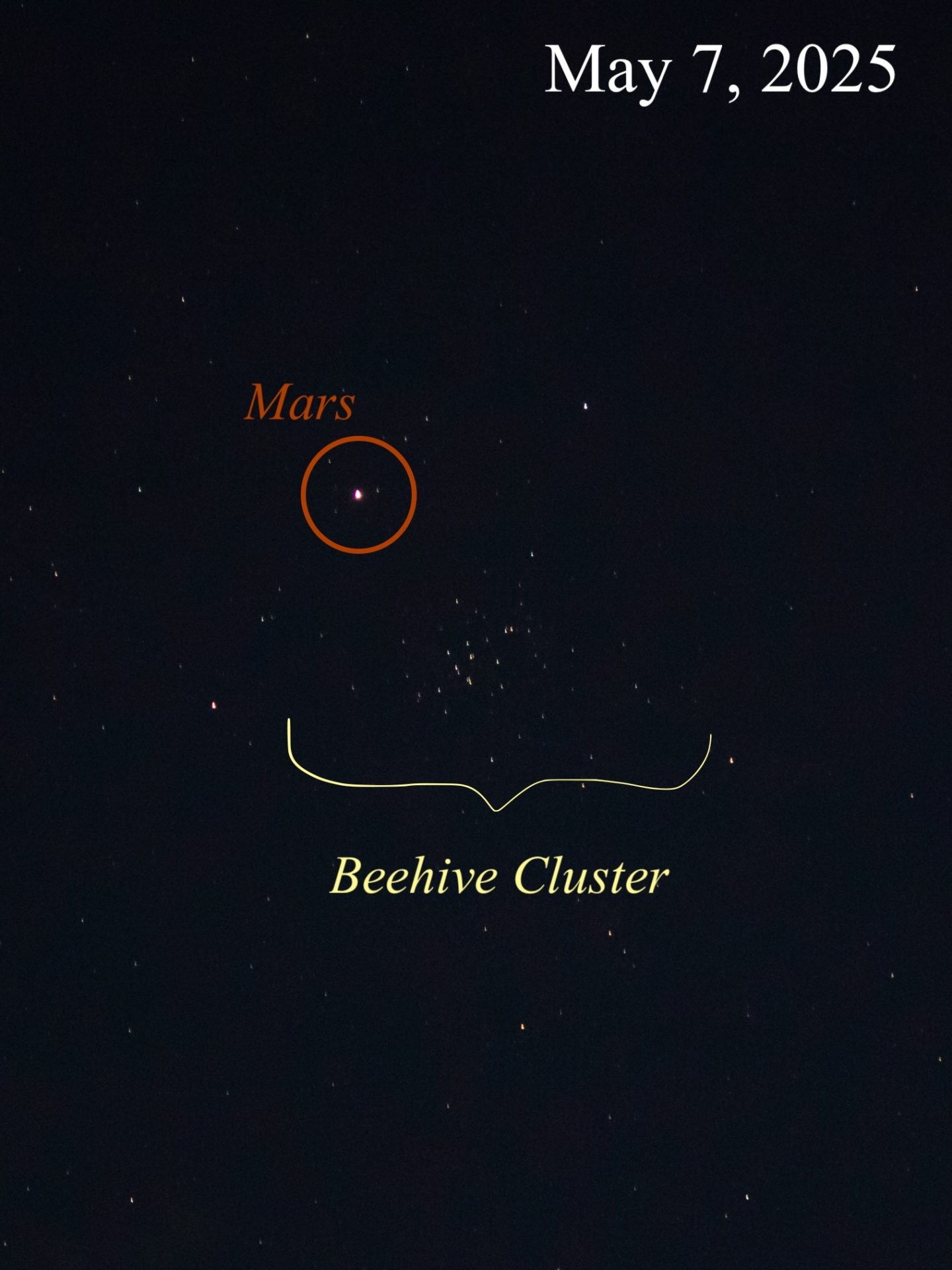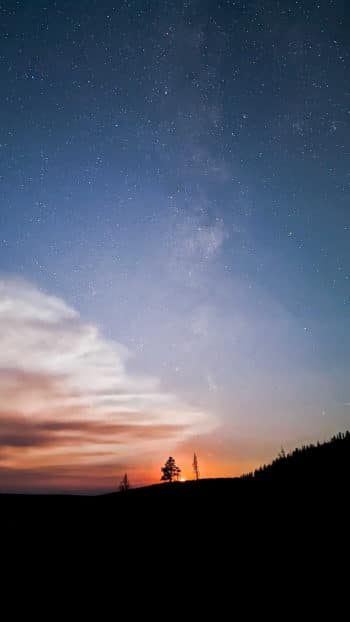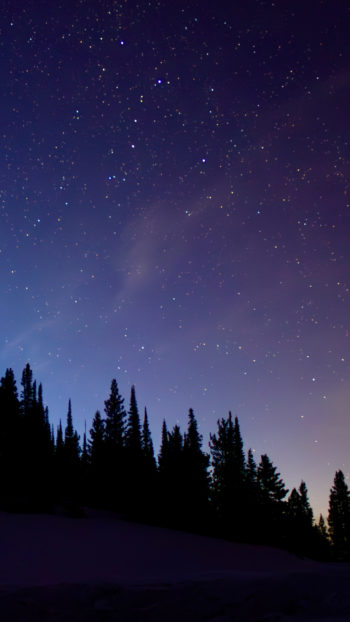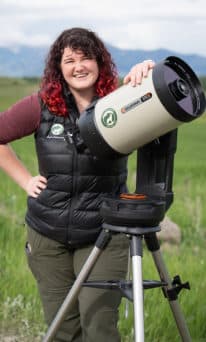Spring is the season of star clusters, and in May 2025 we can observe a stunning conjunction of Mars and the Beehive Cluster. The two were closest to each other on May 4th, but the bright moon nearby washed out some of the details. Now, with the moon moving further away each night, the area around the cluster is clearer from May 7th onward. The two celestial wonders will remain in the same 10×50 binocular field until around May 17th, 2025.
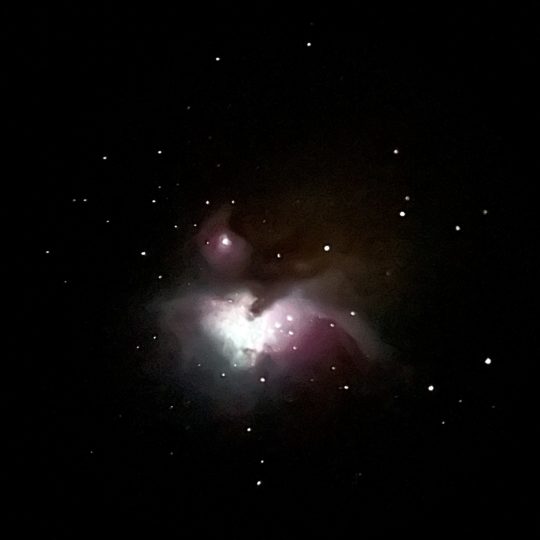
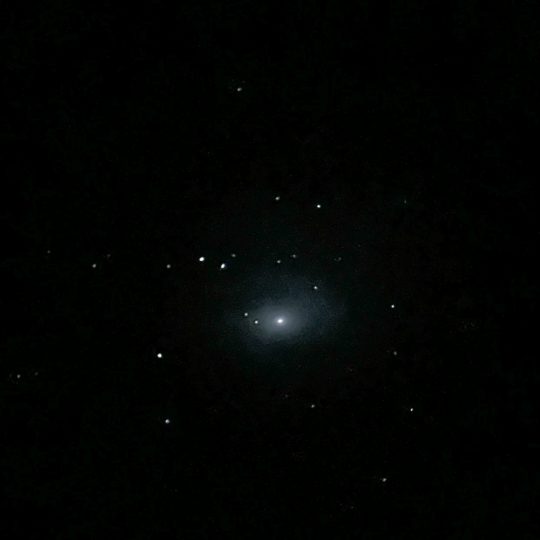
What is a Conjunction?
A conjunction is an apparent alignment of two or more objects in the night sky. The word “apparent” is very important here; most of the time, these alignments are not two bodies actually moving close together. It’s an illusion based on our perspective from Earth.
Distances and Appearances in the Night Sky
Many of the objects in the night sky are extraordinarily far apart in three-dimensional space. But from our viewpoint on Earth, distant objects can appear right next to much closer objects. Think of those photos where people pretend to hold up the Leaning Tower of Pisa: the tourist isn’t really that close to the tower, and the tower isn’t really as small as the tourist, but the perspective makes them look like they are right next to each other.
Why Conjunctions are Rare
Faraway objects like stars and galaxies remain fixed in their position relative to Earth. Astronomical objects change over millions or billions of years, so they’ve hardly moved since humans began observing them. Objects such as asteroids, comets, and planets can move dramatically across the sky because they’re so much closer to Earth.
The Motion of Mars and Other Planets
The planets in our solar system move predictably, so scientists can use mathematics and computer simulations to determine their future positions. The apparent motion of the planets is based on both their orbit and Earth’s orbit, so conjunctions involving the planets don’t happen every year, but rather on longer scales.
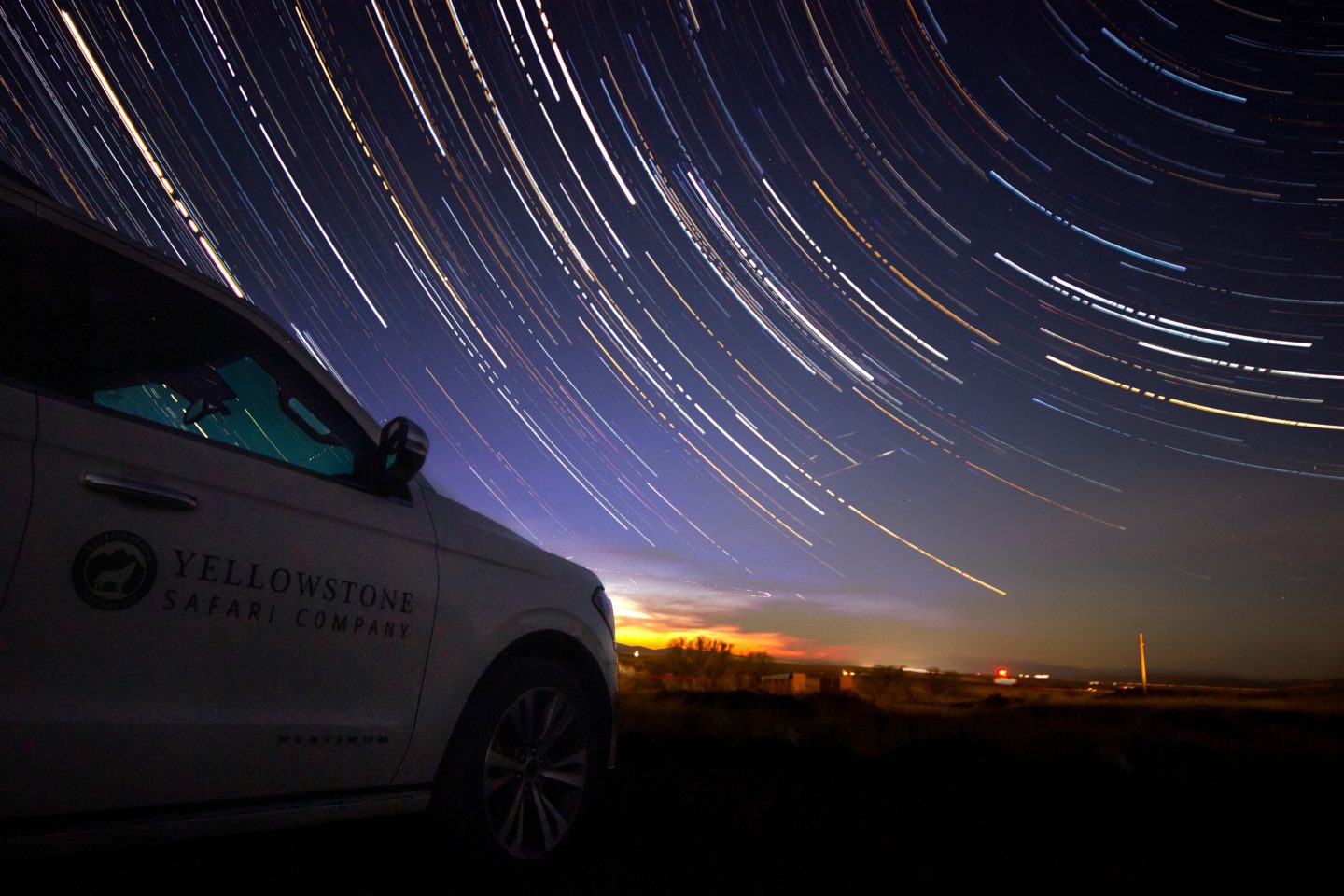
Mars and the Beehive Cluster: Brief Celestial Neighbors
Mars follows a path of motion set by both its orbit and Earth’s orbit. It takes Mars about two years to return to the same area of the sky. The next conjunction of Mars and the Beehive Cluster will be in the early morning hours of mid-October 2026. On October 11th, 2026 Mars will even appear to be inside the cluster as it passes directly in front of it!
Mars: The Red Planet
Mars is one of the five planets visible with the naked eye, along with Mercury, Venus, Jupiter, and Saturn. To find it in the night sky, look for a bright orange dot that does not twinkle. Jupiter is also visible in the sky, but it’s brighter and closer to the horizon; Mars is closer to the zenith, the point directly overhead. The distance between Earth and Mars varies throughout the year; right now, it is about 139 million miles away. Mars is a rocky planet, and it’s the second closest planet to Earth. Its distinctive color is caused by oxidized iron on the surface, creating rusty red dust.
The Beehive Cluster: A Nearby Open Star Cluster
The Beehive Cluster is an open star cluster approximately 610 light-years from Earth. This means that it would take light, the fastest thing in the universe, 610 years to travel between the Beehive Cluster and Earth. The cluster is over 2 million times further away than Mars, but because of its size, it still appears much larger! An open star cluster is a collection of stars inside our galaxy that all formed from the same molecular cloud. These clusters are “open” because there is ample space between the stars, meaning the gravitational pull between them is not very strong. Globular clusters, the other type of star cluster, contain many more stars which are tightly bound by strong gravity. The Beehive Cluster holds about a thousand stars, many of which are similar to our own Sun. Of these thousand stars, we know that several even have their own planets.
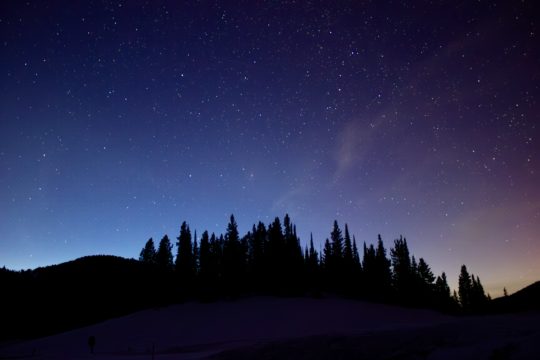
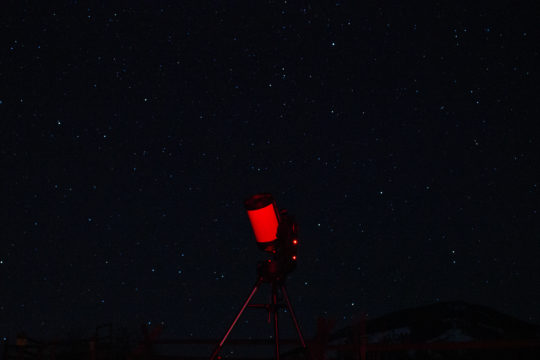
How to View the Conjunction
The conjunction of Mars and the Beehive Cluster is a fantastic opportunity for any stargazer to see an impressive celestial event. The conjunction can be seen with a pair of binoculars or a small telescope, but a larger telescope would reveal more details in the Beehive Cluster. Like all astronomical events, the conjunction is best seen in areas with dark skies, such as the Greater Yellowstone Ecosystem.
Binoculars – Enhancing Your Eyes
The easiest way to see the conjunction of Mars and the Beehive Cluster is with a pair of binoculars! Mars is easy to spot even in light-polluted areas. Point your binoculars toward the red planet, and you should see the Beehive Cluster in the same field. To see more detail, move to an area with low light pollution and high altitude; the view will be especially stunning from locations such as Yellowstone National Park.
Telescopes – Exploring Details
The Beehive Cluster is beautiful through a pair of binoculars, but a telescope will bring out even more details. In an area with very dark skies, you might be able to see differences in the color of the stars, or more stars that would otherwise be invisible. With excellent viewing conditions and a good telescope, you might even be able to see more details in the planet Mars.
Naked Eyes – Visibility in the Darkest Skies
Under very dark skies, the Beehive Cluster is visible with the naked eye, and it’s a sight to behold! It appears as a small, fuzzy, almost cloud-like object. Chances to spot the Beehive Cluster with your naked eye improve as the moon moves further away from it in the coming weeks. Mars is always visible with the naked eye whenever it’s aligned with Earth
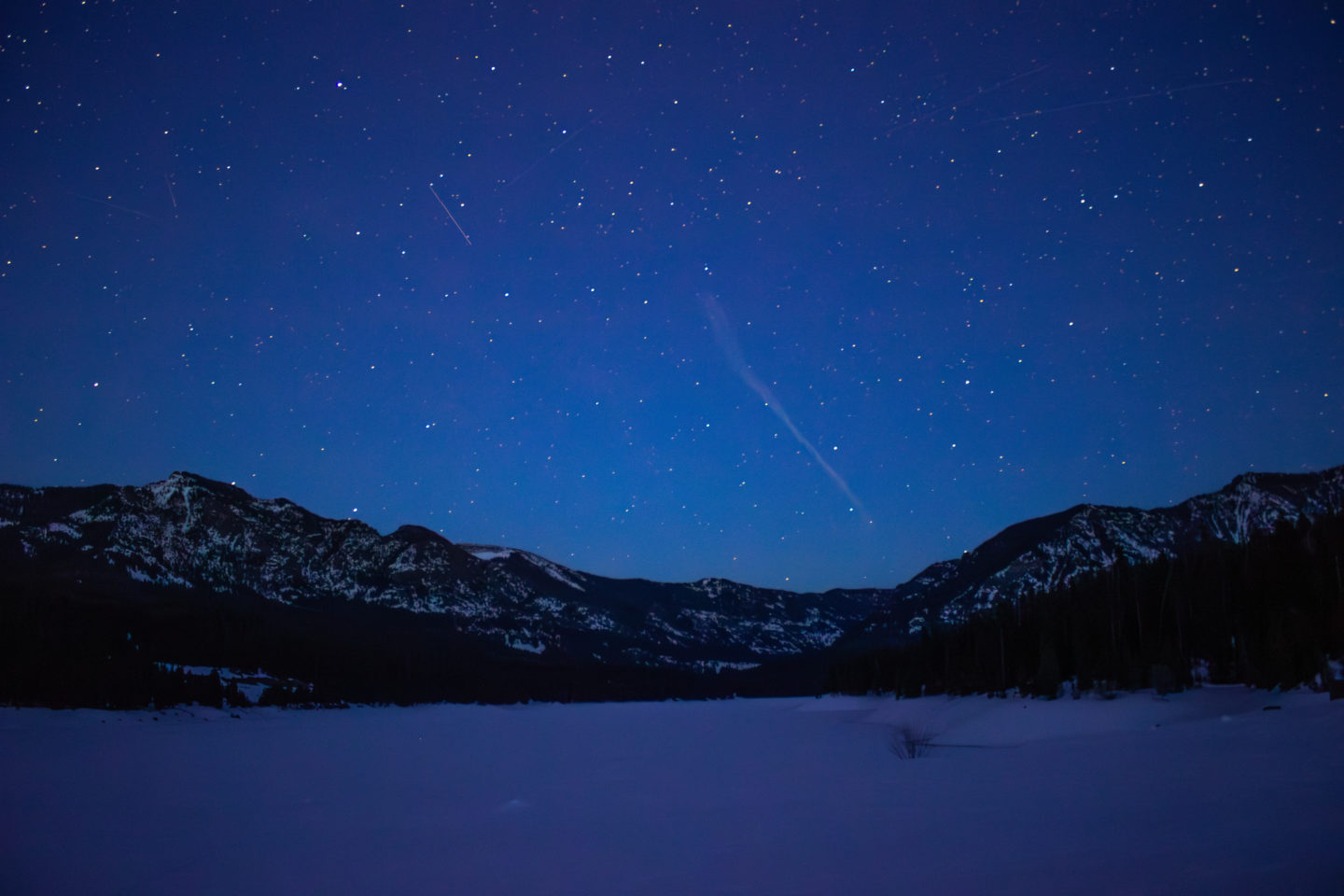
For an unforgettable stargazing experience in the Greater Yellowstone Ecosystem, join us on our stargazing tours. With our expert astronomy guides equipped with endless knowledge and sophisticated, top-of-the-line equipment, we’ll show you the stars as you’ve never seen them before!
FAQs
When can I see the conjunction of Mars and the Beehive Cluster?
This impressive celestial event will take place during early May. The two objects will be visible in the same binocular field of view until around May 17th, 2025.
When will there be another conjunction like this?
Mars takes about two years to return to the same area of the sky. Its next conjunction with the Beehive Cluster will be in October 2026.
Do I need a telescope to see this conjunction?
No, but binoculars will enhance your experience! If you are observing from a very dark location, you might be able to catch this event with your naked eye. A telescope would bring out further detail in both the planet Mars and the Beehive Cluster.
Can I view the conjunction in Yellowstone?
Yes! Yellowstone National Park is an excellent spot for viewing celestial events due to its high elevation and distance from light-polluted areas. If you plan on going into the park to view this conjunction, be careful of wildlife that might be active at night.
Is there a risk of encountering wildlife while stargazing?
Yes, always be aware of bears and bison. Stay in open areas and carry bear spray for safety.
Should I take a guided stargazing tour or go on my own?
A guided tour offers expert knowledge, safety, and access to top-tier telescopes and dark-sky locations. It is an excellent way to view special celestial events like the conjunction of Mars and the Beehive Cluster!

